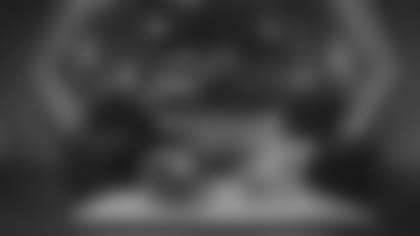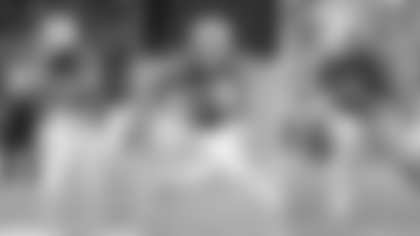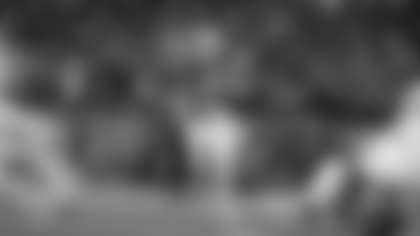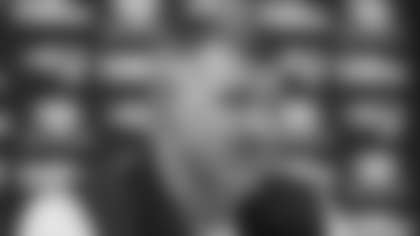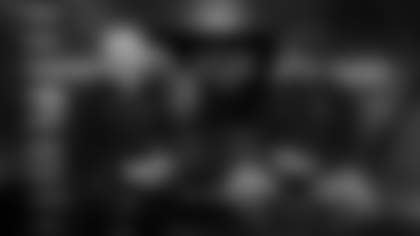Q: Did the PUP guys like Tre' Jackson just run out of time to get back on the active roster? How did that situation unfold?
BB: Yeah, he won't play this year.
Q: Is Sebastian Vollmer in the same situation as Jackson?
BB: Yeah.
Q: Do you feel like the team was able to get in a good day of work yesterday during their time in the building?
BB: Yeah, it was a good day yesterday. Yeah. We'll pick up on a couple of things today. There were a couple of things that we didn't do yesterday but we'll get to those today.
Q: You've seen an opponent like Brandon Marshall plenty throughout his career. What kind of a player is he at this stage in his career?
BB: Yeah, he looks the same. All of the things we've said about him in the past; I don't really see much difference.
Q: I know what the answer to this question is but I have to ask it.
BB: So why are we going to ask it then?
Q: Do you expect Tom Brady to play this weekend?
BB: We'll list Tom [Brady] on the injury report like we always do, like everybody else. Is that the answer you were hoping for?
Q: Not hoping for but expecting.
BB: OK, good. I don't want to disappoint you.
Q: What have you seen from Wesley Johnson on the Jets offensive line since he stepped in for Nick Mangold?
BB: He's a pretty versatile player. We saw him coming out of Vanderbilt. He played tackle down there. He's played guard, center. He seems pretty smart and aware in there of handling the different communication and adjustments, shotgun snaps and all of that, so he's done a good job for them.
Q: Are there times defensively where quarterback pressures can have just as much of an impact as an actual sack?
BB: Yeah, sure. All of it's important. Coverage is important, rushing the quarterback is important.
Q: Do you feel like getting pressure on the quarterback can be an indicator of the performance of the defensive line despite the fact they may not have the sack numbers that stand out?
BB: Yeah, well I think you've got to look at the individual plays. If the quarterback just catches the ball and throws it, I mean, I don't care what you have. You're not going to really get any pressure but you have to defend the play. The quarterback - the longer he holds the ball then the more pressure you would expect to get on the quarterback or you'd want to get on the quarterback. The more guys you rush, the more pressure you would expect to get on the quarterback. Again, there's a point where certain plays the ball just comes out of his hand. You can't get there. I don't care if you send everybody. So it's really a result of the play. If you stop them on third-down, if you stop them in the red-area, if you stop them on first-down and put them in second-and-long, those are good plays. I don't care if you have pressure or have coverage. Whatever it is, you're happy with those plays. If you don't, then find a way to do them better.
Q: A guy like Chris Long hasn't necessarily gotten a lot of sacks this year but how do you feel he's done at applying pressure on the quarterback?
BB: Yeah, I think Chris [Long] has given us a lot of snaps this year. He's given us a lot of good snaps. He plays hard, plays with good technique, is a smart, aware player. He's given us plays in the passing game. He's given us plays in the running game. Like every player, there are things he can work on. We can say that about all of us.
Q: How impressed have you been with Martellus Bennett and the toughness he has shown to fight through injuries?
BB: Yeah, he's shown good toughness. He's been a very dependable player for us in terms of being out there all the way through the spring, OTA's, training camp, regular season. It's one of those positions - offensive line, tight end, linebacker, running back - those guys get hit a lot. They are in a lot of contact plays. Part of those positions, I mean it's true of all positions, too. I'm not trying to single them out, but there's contact pretty much on every play for them. Part of those positions is durability.
Q: You guys have limited the amount of snaps on defense where you've used a traditional style of bigger defensive tackles. Is that by design to get faster or is it just difficult to find those types of players who can rush the passer on all three downs?
BB: Well again, third-down is really a situation down. So it depends on what the situation is, what they have, what you're trying to do. I'd say you put the players on the field that you feel like can best perform in that situation.
Q: Those formations where you have four edge rushers along with a defensive tackle - did those formations start back in 2011 when the Giants defense utilized the speed rush?
BB: Well again, I think your definition of those players - it probably depends on just how you want to call it. I mean, what do you want to call [Dominique] Easley? Do you want to call Easley a defensive tackle? I mean, whatever he was, 270-something pounds. Is he a tackle? Is [Jabaal] Sheard an end? It's just a matter of semantics in some cases. I would say that we've had a similar group of players on the field in a lot of those situations for the last three or four years. That's the way I look at it. I mean, [Dont'a] Hightower - what do you want to call him? Is he an end? Is he a linebacker? Is he a tackle? He's 260-something pounds and he's played all of them. Chris Long is an end. He's played those positions. Sheard's played those positions. Easley's played those positions. Geneo Grissom's played some of those positons. [Anthony] Johnson when he was here, I mean, what do you want to call him? I think you're looking at a lot of similar type of athlete in some of those spots. Whatever the positions is, it is. But it's a similar type of athlete.
Q: Is it difficult to find that type of 300-pound lineman to stick in there that can stay on the field on third-down to rush the passer?
BB: Well, I wouldn't say to stick in there. But I mean, yeah, like Richard Seymour. He was the sixth pick of the draft. Those guys don't grow on trees. Leonard Williams, he was the - I don't know - sixth, fifth pick of the draft, whatever it was. Those guys - Sheldon Richardson, [Muhammad] Wilkerson - I mean, a lot of those guys aren't hanging around in the eighth round now, ninth round, free agency. They're not there then. Yeah, they're definitely harder to find. They're definitely harder to find. That's why they go so fast.
Q: What type of challenges do you hope to present to a defense when you line up James White and Dion Lewis in the backfield together?
BB: Yeah, I think it presents a couple of different options to a defense. If you have a tight end and a back in there then I think they're pretty sure the tight end isn't going to handle the ball in the running game. When you have two backs in there then that's a little bit of a different story. The tight end routes and the back routes are a little bit different, so tight ends have certain advantages, certainly in our case size, length. There's a little bit of diversity with a back relative to a tight end so certainly a tight end is a better on-the-line blocker. Both [are] skill players, both can do things. They're different. We can put two backs in there like what the Jets do. They do some of that, too, with [Chris] Ivory and [Bilal] Powell, or [Matt] Forte and Powell this year. They move a guy out of the backfield so which guy is it? It's not a tight end and a back. It's now two backs and how do you treat them and so forth. It's another way to use those guys and put another log on the fire for the defense that they've got to make some kind of adjustment to. I'm not saying it's the hardest adjustment in the history of the game, but it's another one that you just have to deal with.
Q: What do you remember from 10 years ago when the decision was made to remove the grass from Gillette Stadium and install the field turf and what went into that decision at the time?
BB: If I remember right that was after the Baltimore game.
Q: It was after the home game versus the Jets.
BB: When was the Baltimore game?
Q: I believe there was a reworking of the field surface after the Indianapolis game that year and then the new turf was put in before playing Chicago at home in Week 12.
BB: Right, well there were a few games in there that were - the Ravens game was one game. The Jets game was another game. I think there was another one in there somewhere. Look, the reality of it is it's just hard to grow grass. The technology's changed in the last 10 years relative to grass growing. Not that I'm a big expert on that but that's what's been represented to me and I think that's true. We've played on some great grass fields. Cleveland's field was great, outstanding. Green Bay a couple of years ago was good. Pittsburgh was good this year. I know the Ravens went to grass this year. We played in Philadelphia. That field is pretty good. I think there are more of those in this northern area and they all seem to be doing pretty well from our experience in the past two to three years on them. Going back to that time, it was tough. We had to re-sod the field a couple of times at the end of the year and in the playoffs, and then in the 2006 season during the season it just got bad. You can't grow it, so you either play on it or come in and re-sod it. I don't think either one was a great option then. But I think overall it was a great job to get the field in as quickly as we did and turn it around. But I think at that point we were looking at the prospect of playing however many more games on not really the surface that I would say playable, but played better.
Q: It seems like an extreme measure to replace a field in the middle of a season, what was the reasoning behind that decision?
BB: It's a concern about everything. Injuries are a factor; quality of the games is a factor. Being able to - if you have a good football team, if you have a competitive team, you want to give them a chance to play. You don't want to go out there and slop around every week and play in a mud bowl. When you're playing on a surface that's, I won't say in bad condition, but inconsistent condition - the outside of the field is sort of OK, the inside of the field is a mud pit. Those are hard conditions for players to play on because it's not consistent within the play, or it's frozen on part of the field and it's not frozen on the other part of the field. It's tough to put the players in those situations. At that time, that's what we thought. I talked to Robert [Kraft] about it. At that time we felt like it was the best thing to do and we did it. Maybe there will be another point where we'll make a different decision, I don't know, but that's what where it was then.
Q: Would you agree that last week's game was Vincent Valentine's best and most productive performance of the year?
BB: I thought he did a good job. I'd say he has good plays every week and there are plays that he could have played better on in the games that he's played. He's definitely, I'd say an improving player. I don't know, but it's headed in the right direction and he's certainly had some positive plays, I'd say pretty much in every game. There might have been a couple more last week, but I'd say it's trending the right way.
Q: How has Vincent Valentine come along from a conditioning standpoint in his first year in the program?
BB: Good. I think really, I think all of our players are in good condition this year. I think Moses [Cabrera] has done a good job. Guys like [Alan] Branch have played more snaps than he's ever played. Malcom [Brown] has played a lot of snaps, Vincent [Valentine]. Our offensive line, those guys have played a lot of snaps. I'm talking about the bigger guys, now. I think our conditioning has been good and we've had a lot of guys play, again in those positions, a lot of those guys have played a lot of football, a lot of snaps, and I haven't gotten the sense - last week was a good test defensively because of the tempo of the game and so forth that it didn't feel like that was an issue. I think overall the team's trained hard. They trained hard in the offseason; they worked hard in training camp. Again, we've been relatively healthy so we've been able to stay out there. A lot of times the conditioning declines a little bit when a player misses three, four, five weeks then comes back. He's back, but he's maybe not in the same condition he would be in if he hadn't missed that amount of time. I'd say all those guys are doing a good job on that. But look, it's always a little bit more of a challenge for the rookies, but overall, this group, we really haven't had any issues with any of them, especially on the weight end of it. I mean, [Joe] Thuney, [Ted] Karras, [Vincent] Valentine, [Woodrow] Hamilton, none of those guys have been weight issues at all.
Q: Is Vincent Valentine the kind of guy who would be able to play a little bit more if you needed him to?
BB: From a conditioning standpoint? Yeah, I don't think that's an issue.
*Q: You guys are at 56 percent pass, 44 percent run this year which is a little bit more balanced than last year. What has the commitment to the ground game done for the offense? *
BB: I mean, when it's good, it helps us. Like I said before, I'm for moving the ball and scoring points, so if that's throwing it, if that's running it, as long as we move the ball and score points, that's good. The better balanced you are, I think there is certainly a benefit to that. It helps the other complementary part of the game, the passing game helps the running game, the running game helps the passing game, which gives the defense more things to worry about and more things they have to defend, and you have more ways to attack them. Sometimes it tilts one way or the other. We run the ball 40 times or in the high 30s. Some weeks we run it in the teens. It's hard to keep calling runs or passes if they're not working well. I mean, I'm not going to call 40 runs for 53 yards and say, 'Well, we ran it 40 times.' I mean, we're not doing that. We know if we run it, we're going to call runs. We know if we throw it, we make yards and we're going to throw it.
Q: There are some familiar faces on the Jets defense in Anthony Johnson and Darryl Roberts. Are they using Anthony Johnson the same way you guys did?
BB: Yeah, he's been in for some goal-line situations. They put the big guys inside. Darryl [Roberts], they've matched up some. He's played some inside, but I'd say primarily on the perimeter in the last couple of weeks when Marcus Williams got hurt in the Miami game, he's pretty much really been the third corner. [Buster] Skrine moves inside and [Darrelle] Revis stays outside unless they matchup, and if they match up, then they match up with wherever the guys are, then they match to them.
Q: How has Leonard Williams come along in his second year now?
BB: Really good. Tough to block, disruptive player, impact player; running game, passing game. They put him on the nose a decent amount when they play their five-down look and get him isolated on the centers. He's been very disruptive there, been hard to block. He plays some three-technique when they get into their four-man rush and they put him out at end, so they go with [Sheldon] Richardson, [Muhammed] Wilkerson and him, and then whoever the fourth guy is. So he can play out on the tackle when they play three-technique, and then they use him some on the nose in their five-down scheme, so he's hard to block no matter where he is. He's long, quick and has very good leverage and strength for as long as he is. He plays with a good pad level and he's got good leverage. He's a good power rusher but he's long and he can use his arm overs and his length and he's got the quickness on stunts and games to be disruptive, too. He's just a really good player; plays hard, makes some plays from the back side. He's a good player; hard to block, long, can tip balls. He's a problem.
*Q: Is his build more like a Richard Seymour type of build? *
BB: Yeah, [Richard] Seymour, Tommy Kelly, that kind of six - whatever he is, six-four, six-five, however big he is. He looks big, I mean, he's got long arms, he plays long. Those guys are tough matchups inside when they can do all those things, when you're not just moving a big guy in there to take up space, but when they can actually play like a tackle and play like an end at either spot. Just like when you move him out to end, they kind of power out there. For some of the taller tackles that have trouble getting down low, he just kind of powers through them and they can't handle his quickness; reaches blocks and he undercuts them, things like that. He's a tough guy to block everywhere; really good player.







